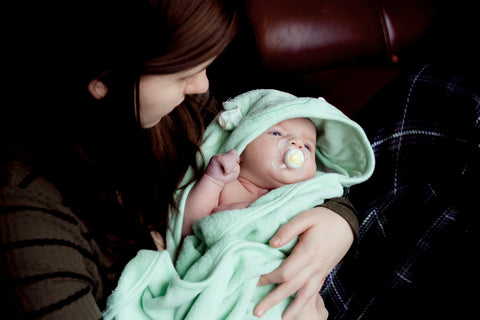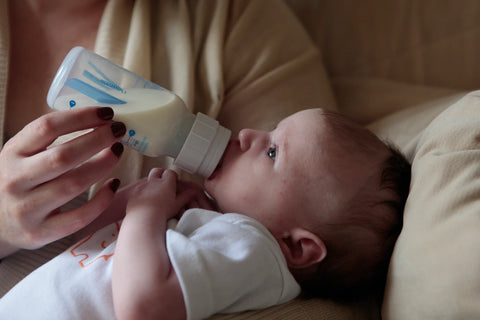How Much Should a Newborn Eat?
•Posted on October 15 2022

When babies are born and take their first sip of milk, parents start to worry about feeding their babies. Especially in the first three months of life, which is a period of rapid growth and development, milk is the top priority for babies. If you want to grow well, you need to drink milk, but how to feed your 0-3 month old baby scientifically is a problem for many parents.
As parents, we are worried that our babies are not getting enough to eat, but we are also worried that they will not get enough to eat, so we are full of questions about feeding our babies. How often should you feed your baby? How much milk is the right amount to feed? Is the baby full? These are all questions that plague us.
Raising a child is a difficult task, especially for a small baby from 0-3 months of age. In this process, we need to know more about science and grow together with our baby slowly.
Table of content:
- Breastfeeding vs. other
- Preparation for breastfeeding
- When to feed your newborn?
- Is your baby hungry?
- Is your baby full?
Breastfeeding VS. Other
Numerous studies have confirmed that breastfeeding does have health benefits for babies, so we encourage mothers to breastfeed. It is important to start breastfeeding as early as possible after the birth of your baby. The American Academy of Pediatrics recommends starting breastfeeding within one hour of your baby's birth.
Breastfeeding is an instinct, but it is not an easy task to achieve exclusive breastfeeding, as breast pain, low milk supply, mastitis, and mastitis plague many mothers.
Breastfeeding has natural advantages and is the healthiest way to feed your newborn baby with the least economic pressure. Many mothers fail to achieve exclusive breastfeeding because they do not have the right breastfeeding skills.
If you want to know more about breastfeeding, you can check our other article: Four Tips for Breast Feed Baby
Preparation for Breastfeeding
Prepare a place to breastfeed
The mother can sit in a large comfortable chair, recliner, sofa or lean against the bed, or just lie in bed and breastfeed. This is because the process of breastfeeding is not only about providing nourishment for the baby, but also about building a parent-child relationship and giving the mother a chance to be close to him, such as holding him in her arms and making eye contact with him.
Wear comfortable nursing underwear
When breastfeeding, wear comfortable clothes. A breastfeeding bra or top will make it easier for the mother to breastfeed whenever and wherever she wants. Generally comfortable breastfeeding underwear does not have a steel ring, and the material is soft and supportive with good elasticity, so that it will not be too tight because of the rising milk or become too loose after the breast is sucked empty. Some women have been wearing nursing underwear since they were pregnant. The cups of nursing underwear can be turned over to reveal the breasts, so it is important to pay attention to the fit when wearing nursing underwear and not to make the breasts feel constricted and compressed. In addition to nursing underwear, there are also nursing tops that can be lifted.
Don't use an artificial pacifier too early
Artificial pacifiers include "soothers" and "bottles". Some infants do not take breast milk well, and this problem is common in infants who have used bottles and pacifiers. Some babies are very sensitive to the differences between the way they eat breast milk and the way they eat bottles and soothers. There is now good evidence that early use of pacifiers may lead to lower rates of exclusive breastfeeding or shorter duration of breastfeeding, although researchers have not yet determined that pacifiers are the cause of breastfeeding failure.
Therefore, it is recommended that babies be kept off bottles and pacifiers for the first few weeks of life until parents feel that breastfeeding is no longer a problem and that pacifiers can be used. During this period if the baby seems to be sucking on something, try breastfeeding.
Generally, as soon as breastfeeding becomes smooth, milk production stabilizes and the infant begins to gain weight, this is the time to consider using a soother to meet the infant's additional sucking needs
When to feed your newborn?
Breastfeeding has the highest success rate when initiated immediately after delivery (within 1 hour after delivery), as long as the health of the mother and newborn allows. The breastfeeding habits of breastfed infants vary very much. They usually consume milk more frequently than infants who are fed formula. Breastfed infants usually eat milk 8 to 12 times per 24 hours, and some even more. Infants can respond quickly to hunger signals, so breastfeeding is an on-demand feeding rather than a timed feeding.
Feeding on demand is currently the most respected feeding method, which is more in line with the physiological characteristics of babies at this stage of 0-3 months of age and can better meet the needs of babies. The World Health Organization defines on-demand feeding as breastfeeding on demand - that is, feeding as soon as the baby needs it, day or night. It depends on the baby's hunger, not on the number of feedings or the time of day, but on whether the baby is hungry as a signal to breastfeed.
Let the baby eat as much as he wants at one breast. After he stops on his own for a while or releases the nipple on his own, give him a burp. If you're not experienced enough to time your breastfeeding at first, or if you don't have enough milk, you can also eat at one breast for 10-15 minutes, burp the baby after sucking it up, and then switch to the other side to continue feeding.

Is your baby hungry?
The hardest part of feeding a newborn is determining correctly what your baby really needs. We advocate feeding your baby on demand, but that doesn't mean you have to feed your baby whenever he or she cries. Many parents use their child's crying as a criterion for judging their baby's hunger, which is likely to result in overfeeding causing obesity and even more serious health problems.
In the event of a crying baby's behavior, we need to observe the baby's state to determine whether he needs to be fed. Early signs of hunger in babies include alertness, increased or decreased physical activity, and increased facial expressions; it is the subsequent manifestation of hunger that is crying.
By observing the specific performance of the baby, we can basically determine whether the baby is hungry or not. Of course, the mother can also determine whether to feed her baby by rising milk. Properly grasp the four methods of identifying baby's hunger:
1. When the baby lies flat, the head always turns to the left or right, and at the same time will open the little mouth as if looking for something.
2. Sucks everything around the mouth, such as collars, cuffs, and quilts, and eats them with gusto.
3. Touching the corner of the baby's mouth with a finger, the baby will quickly turn to the finger and may also suck on the finger.
4. When held in the arms, the baby will always turn his head to the nipple or pacifier and open his mouth.
Is your baby full?
After determining the baby's hunger, how do we grasp the amount of feeding, to determine whether the baby is full?
1. Judging from the baby's swallowing action:
Baby sucking slow and deep, can see the swallowing action, and can hear the sound of swallowing, and so baby eat about 10-15 minutes, swallowing sound gradually become smaller, that the baby is full.
2. Judging from the baby's mental state:
When hungry, the baby will have the action of looking for the nipple or crying, after feeding will naturally turn the head away, no longer sucking, smiling at you or not crying, easy to enter the sleep state, indicating that the child is full. If the baby cries after feeding, or bites the nipple and does not let go, or wakes up after less than two hours of sleep, it means that the milk is not enough.
3. Judging from the number and nature of the baby's bowel movements:
The number of urination decreases, less than 5-6 times/day. If the stool is constipated, thin, greenish or the number of bowel movements increases and the amount of discharge is small, it means that the amount of milk is not enough and the baby is not fed.

4. Judging from the baby's weight:
The change of baby's weight can often indicate whether the baby is full or hungry. 6 months old babies, on average, gain 600 grams of weight per month or at least 125 grams per week. If the baby's weight gain does not reach the above-mentioned standards, and the difference is large, after excluding diseases, it mostly indicates that the baby is not fed, not drinking enough milk, and not keeping up with nutrition.
5. Judging from mother's breast perception:
If breastfeeding, after the baby is full, the breasts will change from full to flaccid.
More Posts
-
Night Sweats During...
Women are prone to night sweats in early pregnancy, which varies from person to person and may last up to a month after delivery before ending.Befo...
Read More -
Feeding Your Baby w...
When you have a baby, a bottle is definitely indispensable. Whether it is mixed feeding, formula feeding, or breastfeeding bottle feeding, the heal...
Read More -
Disposable nappy or...
Have you calculated how many diapers you need to raise a child? If you try to stop using diapers from the age of 2, you'll need about 4,000 diapers...
Read More





Comments
0 Comments
Leave a Comment